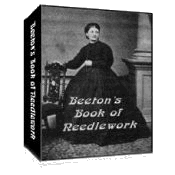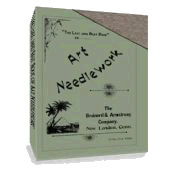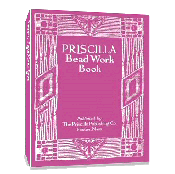Proper Tools for Embroidery
Proper tools for embroidery are discussed in this continuance of the article The Theory and Method of Embroidery, Part 1. Equipment - How to Prepare for Work written by Mrs. L. Barton Wilson.
Published in Corticelli Home Needlework, 1899
Edited by M. Schlueter
We need the proper tools for our work. The requirements for the hand stitches are fewer than for embroidery which is to be done in a frame or hoop.

Fig. 2. Showing Correct Position at a Frame – Commencing Work.
The first requirement for framed work is a high table. It should stand about thirty inches. The chair used should be low. One usually sits slightly sidewise to a hoop, and a rocking chair is therefore usable and comfortable because the position can be shifted. It is necessary to sit squarely in front of a bar frame, therefore a low straight chair is better. The reason for a high table and a low chair is evident. It forces one to sit straight. The lungs are not compressed and one can work for hours without fatigue. See Fig. 2 above. A cramped position and cramped hands will never produce broad, even work. There is as much in what may be called "touch" in embroidery as there is in music or painting, and the proper position at the embroidery frame is not less important to the result to be produced than the proper position at the piano.
The most convenient and altogether scientific way of stretching fabrics is in the bar frame. The entire linen can be set up at once. When finished it can be "set," that is, dampened and pressed, in the most satisfactory of all ways, before it is removed from the frame. It should be thoroughly dampened and dried quickly. When cut out it is absolutely perfect. See article on "To Launder Embroidered Linens."
The linen should be laced into the frame very firmly. It takes a little time to do this, but it will repay the trouble in the many advantages it will have for the worker. A piece of work thus laced into a frame is kept in good order throughout the time it takes to do it. Pieces held in the hand or drawn many times through the hoop are often in a condition to be washed by the time they are finished. If one is some weeks or months in embroidering a centerpiece it is more than likely to be soiled, but if it can be mounted complete in a frame it is very easy to keep it perfectly fresh.
Mounting the fabric

Fig. 1. Cording the Edge
The first step is mounting a fabric is to cord its edge. Turn the edges straight to a thread about one half inch over a firm cord and sew them down with fairly small stitches. See Fig. 1. On heavier linens sew with double Corticelli Filo Silk. It is a good plan to save waste threads of Filo for this work, for no thread is so strong and satisfactory for all this sort of preliminary work on fabrics to be embroidered. If the material is very fine bind it first with a strip of linen lawn and cord this. Now place the frame flat on the table in position so it will form a hollow square fully an .inch larger both ways than the linen to be mounted. Fasten the bars firmly by turning the thumb screws very tight.

Fig. 3. Stamped Linen Laced Into Frame Ready to Work
Thread a sail needle with firm cord four times the length of the side of the linen to be laced. Each side should be laced with a separate cord. Commence lacing from the middle of each side of the frame and linen in order to avoid the necessity of carrying a very long thread through each stitch. Carry the cord over the frame and through the linen just inside the corded edge. Half the stitches will be carried over and half under the bar in order to have the whole laced the same way. Take the stitches about two inches apart. Fasten each row separately, at the corners. Do not tighten the work until all four side as are laced, then lace up one side quite close to one bar, perfectly straight.

Fig. 4. Sending the Needle Down
This done, stretch it from the opposite side by lacing that. Draw evenly and gradually. Now lace the third and stretch that by drawing up the fourth. In this first lacing, tie the ends temporarily only. Continue to tighten the threads and correct in this way any unevenness which may appear in the directions of the woof and warp. Finally fasten the four corners by slipping the ends of the cords under three or four lacing stitches on top of the bars and 'knotting the last one. This also tightens the material. The absolute necessity of stretching straight has already been explained. Fig, 3 shows fully the details of the framed linen.

Fig. 5. The Thread Drawn Down Full Length
Hemp twine is fairly satisfactory for cording and lacing. It wears, however, and therefore it is better to use a stiff, wiry tying cord.
When the linen is drawn tight the frame will likely wring more or less, It should be placed on the front of the table, forced flat very gradually , and tied or weighted down or secured by clamps. Of course the edge should project over the table the width of the design.

Fig. 6. The Thread Drawn Up Full Length
One may reach twelve inches into a frame. Beyond this the hands cannot be controlled. Hence the necessity of lacing the design as close as possible to the bars, for every inch counts when one is working. Yet sufficient space must be allowed for firm stretching. If we are to work directly upon the linen as in the case of center pieces, etc., It is now completely ready, but silk or other fabrics which it is not practicable to stretch should be lightly pasted to framed butchers' linen and the stitches taken through both grounds. We may consider our frames, then, as essential instruments in our work to be used consistently with such ground material as we undertake to work upon.
The table with frame upon it should be placed with its left end against the window jamb and its width should occupy about half the width of the window. The lower part of the window should be curtained with a full half curtain to prevent the light from shining through under the framed fabric. Dark green india silk makes a very useful curtain. A reversed holland shade is also very convenient. A dark apron over the lap is also a great help in preventing reflection under the frame. The light thus falls from above and from the left so that no shadow is cast in front of the right hand.
My note: It was strongly stressed to needleworkers of the Victorian era, that proper tools for embroidery were not a convenience but a necessity. Mrs. Barton Wilson noted the need to take embroidery very seriously and to assure oneself a beautiful outcome these tools should be used. I am sure, then, as now, not all ladies had what she considered the "proper tools" available to them, for one reason or another and still produced beautiful embroidery. So... if you don't have the best frame or hoop or your thread isn't the top of the line silk, don't give up. Substitute with the best you have, whether they are the proper tools or not, use the tips and tricks already discussed in this article that you find applicable to you, and begin your journey into embroidery.
Continue to read article Theory and Method of Embroidery:
Page 3 - Other Necessary Instruments
Return to top Proper Tools for Embroidery
The Last and Best Book of Art Needlework
Over 100 pages of authentic Victorian instructions and patterns from 1895!
FREE
Beeton's Book Of Needlework

433 pages!
Sign up for VEAC! Everything you wanted to know about Victorian embroidery, needlework, crafts and more!
Priscilla Bead Work Book
Make Beautiful Victorian Beaded Purses, Jewelry & Accessories - Starting
TODAY!



